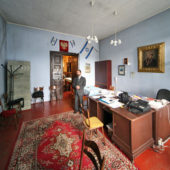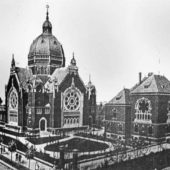Unobtrusively located in a mixed use building, this is the last remaining synagogue in a once vibrant Jewish community.
Jewish history in Katowice began with one Jewish man who owned an inn on the site of what is today’s Skarbek department store, while also managing stables and a small brewery. Persecution under Prussian rule began early and for a Jew to get along peacefully, it was expected that he or she would change their name (to a non-Jewish name) and write in German. They were then granted the ability to move about freely and live anywhere in town. In 1846 a direct railway line was completed from Germany, and an influx of German Jews arrived in the area. In 1855 the first prayer house was opened and in 1862, the first Synagogue was opened on the corner of today’s ulica 3 Maja and ulica Slowackiego.
The cemetery was purchased in 1866. By 1870 the Jewish community had increased to the point that it made up 10% of Katowice’s total population and by the turn of the 20th century, there were 2,000 Jews in the city. Jews were not only involved in the fields of medicine, law, commerce and banking, but they also owned several large mills and factories. By 1890 the Reform Jews were growing out of their premises and required a larger Synagogue. Max and Ignatz Grunfeld, the architects who had designed the community’s previous Synagogue, were hired to design the new project. After several years of construction, on October 12, 1900 the Great Synagogue in Katowice was completed at 1900 Mickiewicza Street.
Although the Great Synagogue of Katowice was destroyed by the Nazis, the city archives has provided reproductions and original sketches of the building. These, together with postcards made at the turn of the century, give us a good feel for the design and appearance of this masterpiece of design. Katowice Synagogue somehow combines neo-Gothic, neo-Renaissance, eclecticism, and Moorish design to magnificent effect. While it existed, it was one of the most characteristic buildings in the city. This monumental Synagogue could seat 1,120 people, (670 men, 450 women). The opulent dome, which stood above the main prayer room, and the beautiful Gothic windows, caused the Synagogue to stand out from nearby buildings. The brick edifice was used in combination with cream woodwork, which beautifully enhanced the detailed façade styling and impressive stained glass windows. The body of the Synagogue was rectangular in design structure, with a large entrance hall, offices, a chamber of marriage, and then the entrance into the main prayer-room, with the large cross-ribbed vault ceiling and large domed roof.
Katowice is to be thanked for its tremendous contribution to modern Jewry, which took place at the Katowice Conference, on November 6-11, 1884. This conference, was attended by 22 Jews from Russia, France, Germany, Palestine, Romania, Poland and the UK, who discussed the founding of a Jewish nation in the Middle East. It was strongly felt by all that Jews were never going to receive fair treatment in Europe, and some felt that they should all move to Palestine. An interesting conversation, half of a century prior to Israel becoming a nation. In 1901 the Katowice Synagogue hosted the World Zionist Congress. Poland was invaded by Germans in 1939 and at that time, there were approximately 9,000 to 13,000 Polish and German Jews living there. The Synagogue was set on fire by the Nazis on the 4th of September, 1939. Where the Synagogue once stood, there is now an Obelisk commemorating the Jews who were killed in the WWII. Most of the city’s Jews were sent to their doom at Auschwitz. After the war, approximately 1500 Jews returned to Katowice; however, most of them quickly left again. There is very little left of pre-war Jewish life to be seen, except for the neglected Jewish Cemetery and the monument which is in the cemetery.
A small Jewish community center on the second floor of an office-apartment building currently serves as a multi-purpose prayer room and office, featuring the city’s only purpose built kitchen (Kosher). The walls are a buttery-yellow with paned windows on the wall against which is the Aron Kodesh. There are dark wood chair rails with orange paint underneath. The floors are reddish/brown wood. A wooden Aron Kodesh shaped like a wardrobe is against the East wall. A heavy green curtain embroidered with a Star-of-David in gold and also tasseled in gold, is drawn across it. Two lions holding two tablets inscribed in Hebrew with The Ten Commandments are above the Aron Kodesh. A beautiful gilded screen, with hand-painted scenes, is in front of the Aron Kodesh. A simple chandelier drops down in the center of the prayer room, in front of the Aron Kodesh. On either side of the Aron Kodesh is a long table with dark wood benches. In front of one of the long tables and bench is the tevah (reader’s desk). Dark wood pews line the walls of the room. This is a sunny room, that is well cared for. Clearly, this small community continues to keep their Reform Jewish traditions, culture and faith alive.
Photographer’s note regarding their visit to Katowice in 2006:
We found the building but only a plaque in Hebrew and Polish indicated anything Jewish about it. We rang the bell and a female voice answered in Polish. When we said “Hello” she rang us in. The building seemed deserted and neglected. We walked up three or four floors to the top, but there didn’t seem to be any indication of a Jewish office. On the way back down, there was a sign in Polish we couldn’t read on a door. Remembering our experience in Wroclaw, we rang the bell. We were buzzed in.
A lady with a modicum of English asked us what we wanted. We said we wished to visit the synagogue. “Just a moment,” she said. “I will call Mr. Kac (pronounced Katz).” After a brief conversation on the phone, she said, “He will be here in 20 minutes.” She offered us coffee and bottled water while we waited.
In 20 minutes Mr. Kac, the president of the Jewish community, arrived. He spoke good English and invited us into his office where he gave us a short history of the Jewish community of Katovice. Then he opened the door next to us where the small prayer room, aka the synagogue, was located. His office, it turns out, is where the women sit during services.
After our visit here, Mr. Kac graciously walked us around the town showing us former Jewish sites.




